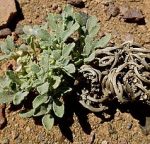 Also known as rose of Jericho, Maryam’s flower, flower of St. Mary, St. Mary’s flower, Mary’s flower, and white mustard flower, this annual herb is native to the deserts of western Asia and is a member of the mustard family, Brassicaceae, that also includes cabbage, broccoli, and alyssum. The prostrate plant grows about 6″ tall and has a heavy tap-root that produces a 12″ wide flat disc like structure of numerous slender branches that bear small, obovate, gray leaves and tiny, white, axillary flowers. When dryness occurs the leaves drop, and the branches contract into a tight ball with the tips at the top and the fruits inside and attached. At this point the wind may break the ball from the root and blow it around as a tumbleweed. The seeds can remain dormant for years and when the rains come again the ball containing them uncurls, the plant seems to come to life again, the seed capsules pop open, and the seeds germinate. The genus name, Anastatica, comes from the Greek word anastasis, meaning resurrection, referring to the fact that no matter how dry the plant gets it can recover its shape by being placed in water. The specific epithet, hierochuntica, comes from the classical name for the town of Jericho, Hierikous.
Also known as rose of Jericho, Maryam’s flower, flower of St. Mary, St. Mary’s flower, Mary’s flower, and white mustard flower, this annual herb is native to the deserts of western Asia and is a member of the mustard family, Brassicaceae, that also includes cabbage, broccoli, and alyssum. The prostrate plant grows about 6″ tall and has a heavy tap-root that produces a 12″ wide flat disc like structure of numerous slender branches that bear small, obovate, gray leaves and tiny, white, axillary flowers. When dryness occurs the leaves drop, and the branches contract into a tight ball with the tips at the top and the fruits inside and attached. At this point the wind may break the ball from the root and blow it around as a tumbleweed. The seeds can remain dormant for years and when the rains come again the ball containing them uncurls, the plant seems to come to life again, the seed capsules pop open, and the seeds germinate. The genus name, Anastatica, comes from the Greek word anastasis, meaning resurrection, referring to the fact that no matter how dry the plant gets it can recover its shape by being placed in water. The specific epithet, hierochuntica, comes from the classical name for the town of Jericho, Hierikous.
Type: Annual
Bloom: Tiny white flowers
Size: 6″ H
Light: Full sun
Soil: Sandy, dry, well-drained but needs water to reproduce.
Hardiness: Not available
Care: Now maintenance
Pests and Diseases: Not available
Propagation: Seed
Companion Plants: None
Outstanding Selections: Not relevant
Photo Credit:Wikipedia